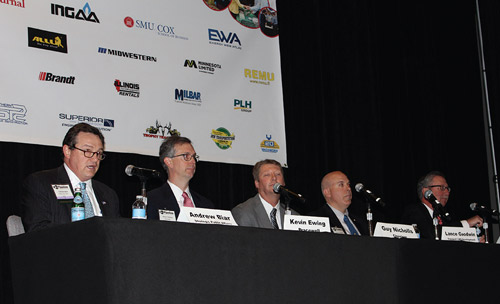May 2019, Vol. 246, No. 5
Features
POC Shifts Back Toward Pipeline Industry Basics
By Pipeline & Gas Journal

The 15th annual Pipeline Opportunities Conference (POC) marked something of a departure from recent years with more speakers and panelists coming from the ranks of operators and contractors.
About 200 participants from all areas of the pipeline industry gathered April 9 at Houston’s JW Marriott to hear a wide range of experts offer their perceptions about the challenges and opportunities ahead for the industry, as well as share insights on how to move forward.
“We knew we wanted to go in a little different direction and get this conference moving in the direction it needs to be going,” Pipeline & Gas Journal Editor Joe Hollier told attendees to open the event.
Kicking off the morning session was Bud Weinstein from Southern Methodist University’s Maguire Energy Institute, and conference newcomer James Coleman, an associate professor of law at SMU, who specializes in energy and regulation.
Coleman remarked that while energy policy remains so unpredictable that “a few votes in Wisconsin can determine whether a pipeline gets built or not,” he cautioned that an incoming president could go further, ordering that no new pipelines, even on at the state level, could be built without an environmental impact statement.
In another timely morning presentation, Don Santa, president and CEO of INGAA discussed the regulatory picture in Washington, D.C. He pointed out that the age of Congress members was becoming increasingly younger, with one-third of the body elected in 2016 or 2018.
Santa cited the proposed Green New Deal as indicative of “a shift we are seeing” and said 29 states, along with the District of Columbia, now have greenhouse gas emission goals in place.
“This is not something that is going to go away,” he said.
Keynote speaker Nick Stavropoulos, who recently retired as president and chief operating officer of PG&E, discussed the importance of instilling a strong safety culture and recognizing the value of safety management systems.
He stressed the importance of regular, rigorous assessments, adding that any incident that occurs affects the public perception of every company in the industry.
Stavropoulos said it is important for employees to feel free to speak up when they see potential threats to safety. He suggested that safety results be tied to compensation packages, much like financial benchmarks are.
“When your people tell you everything is going gloriously well, how do you know what’s really going on?” Stavropoulos said.
Regulatory clarity and shifts in policy on the executive level were mentioned frequently by panelists throughout the program and by several observers in the audience.
Those concerns were dealt with directly in the well-attended afternoon session on FERC procedures. Hosted by Susan Waller, vice president of Stakeholder Engagement at Enbridge, the panel, consisting of Rutter & Roy attorneys Christine Roy and Richard Scott, and Samuel Brothwell, director of research, at Energy Income Partners.
Another afternoon session dealt with the Mega Rule (Pipeline Integrity Rule) and what effects it will likely bring concerning pipeline construction, with Mark Hereth, managing director of Blacksmith Group, and Jeffrey Wiese, senior vice president of Pipeline Integrity at TRC Companies, presiding. With a July 2 publication date predicted, Wiese said, the big question is “How long will operators have to get into compliance?”
A panel on “Changing Energy Infrastructure Climate” closed the event, featuring moderator Georgia Carter, vice president and general counsel for Millennium Pipeline.
She presided over a group consisting of Bobby Huffman, vice president of U.S. Marketing, and Juan Miguel Bermudez, director of Corporate Development, both at Enbridge; Robert Riess, senior vice president and Pipeline Division manager at Henkel & McCoy, Kelly Osborn, president at U.S. Pipeline, and Craig Meier, director at Sunland Construction.
Osborn summed up the situation from the perspective of contractors when he said, “We need three things – pipe, permits and right-of-way.” He added that the last time he remembered building a pipeline uninterrupted, “straight from Point A to Point B,” was in 2003.
In addition, a panel presided over by Andrew Biar, president of Strategic Public Affairs, took up the topic of moving LNG around the United States and the need for additional pipelines to transport the natural gas to production plants.
Additionally, Gulf Energy Information’s Harry Brookby discussed the company’s Energy Web Atlas, an ESRI-based, GIS platform that allows users to integrate real-time project information, export and manipulate data, and gain competitive insights.
The 2020 Pipeline Opportunities Conference, the 16th such event, will be held in spring. P&GJ





Comments